Research on Parking Recommendation Methods Considering Travelers’ Decision Behaviors and Psychological Characteristics
Abstract
1. Introduction
2. Literature Review
3. Survey of Sequential Parking Decision Behavior under Parking Recommendations
3.1. Design and Implementation of the Survey
- (1)
- Personal information of the travelers.
- (2)
- Travelers’ attention to factors influencing parking choice.
- (3)
- The individual psychological thresholds for the factors influencing parking choice.
- (4)
- Stated preference survey on sequential parking decision behaviors.
3.2. Graphic Characteristics and Differential Statistics of the Survey Data
- (1)
- Personal information.
- (2)
- Analysis of the travelers’ attention to the factors influencing parking choice.
- (3)
- Analysis of travelers’ psychological thresholds for the parking factors influencing parking choice.
- (4)
- Choice intention regarding the sequential parking decision process.
4. Parking Recommendation and Individual Parking Decision Process Models
4.1. Parking Recommendation Model
4.1.1. The Parking Recommendation Process, Considering Psychological Thresholds and Attention
4.1.2. Parking Recommendation Schemes That Consider the Interests of Travelers and Managers
4.2. Individual Parking Decision Process Model
5. Parking Simulation and Analysis in Different Parking Recommendation Schemes
5.1. Initial Settings of Parking Simulation
5.2. Analysis of Parking Simulation in Different Parking Recommendation Schemes
- (1)
- The dynamic change in parking occupancy under different parking recommendation schemes.
- (2)
- Evaluation of simulation results in different parking recommendation schemes.
5.3. Analysis of Simulation Results in Different Initial Parking Utilization States
- (1)
- Dynamic change in parking occupancy in different initial parking utilization.
- (2)
- Simulation results in different initial parking utilizations.
5.4. Analysis of Simulation Results for Different Parking Reservation Proportions
- (1)
- Dynamic change in the parking occupancy in different parking reservation proportions.
- (2)
- Simulation results in different parking reservation proportions.
5.5. Analysis of Simulation Results in Different Parking Regulation Thresholds
- (1)
- Dynamic change in parking occupancy in different parking regulation thresholds.
- (2)
- Simulation results in different parking regulation thresholds.
6. Conclusions
Author Contributions
Funding
Institutional Review Board Statement
Informed Consent Statement
Data Availability Statement
Acknowledgments
Conflicts of Interest
References
- Shoup, D.C. Cruising for parking. Transp. Policy 2006, 13, 479–486. [Google Scholar] [CrossRef]
- Zhu, Y.; Ye, X.; Chen, J.; Yan, X.; Wang, T. Impact of Cruising for Parking on Travel Time of Traffic Flow. Sustainability 2020, 12, 3079. [Google Scholar] [CrossRef]
- Giuffrè, T.; Siniscalchi, S.; Tesoriere, G. A novel architecture of parking management for smart cities. Procedia–Soc. Behav. 2012, 53, 16–28. [Google Scholar] [CrossRef]
- Caliskan, M.; Barthels, A.; Scheuermann, B.; Mauve, M. Predicting Parking Lot Occupancy in Vehicular Ad Hoc Networks. In Proceedings of the IEEE 65th Conference on Vehicular Technology, Dublin, Ireland, 22–25 April 2007. [Google Scholar]
- Paul, B. On-Street Parking Management; Deutsche Gesellschaft Für International Zusammenarbeit: Berlin, Germany, 2016. [Google Scholar]
- Arnott, R.; Inci, E. An integrated model of downtown parking and traffic congestion. J. Urban Econ. 2005, 60, 418–442. [Google Scholar] [CrossRef]
- Van der Waerden, P.; Timmermans, H.; da Silva, A.N.R. The influence of personal and trip characteristics on habitual parking behavior. Case Stud. Transp. Policy 2015, 3, 33–36. [Google Scholar] [CrossRef]
- Zhang, R.; Zhu, L. Curbside parking pricing in a city centre using a threshold. Transp. Policy 2016, 52, 16–27. [Google Scholar] [CrossRef]
- Khaliq, A.; van der Waerden, P.; Janssens, D.; Wets, G. A conceptual framework for forecasting car driver’s on-street parking decisions. Transp. Res. Procedia 2019, 37, 131–138. [Google Scholar] [CrossRef]
- Soto, J.J.; Márquez, L.; Macea, L.F. Accounting for attitudes on parking choice: An integrated choice and latent variable approach. Transp. Res. Part A Policy Pract. 2018, 111, 65–77. [Google Scholar] [CrossRef]
- Tian, Q.; Yang, L.; Wang, C.L.; Huang, H.-J. Dynamic pricing for reservation-based parking system: A revenue management method. Transp. Policy 2018, 71, 36–44. [Google Scholar] [CrossRef]
- Lei, C.; Ouyang, Y.F. Dynamic pricing and reservation for intelligent urban parking management. Transp. Res. Part C Emerg. Technol. 2017, 77, 226–244. [Google Scholar] [CrossRef]
- Fahim, A.; Hasan, M.; Chowdhury, M.A. Smart parking systems: Comprehensive review based on various aspects. Heliyon 2021, 7, e07050. [Google Scholar] [CrossRef] [PubMed]
- Cao, J.; Menendez, M. Quantification of potential cruising time savings through intelligent parking services. Transp. Res. Part A Policy Pract. 2018, 116, 151–165. [Google Scholar] [CrossRef]
- Şengör, İ.; Güner, S.; Erdinç, O. Real-time algorithm based intelligent EV parking lot charging management strategy providing PLL type demand response program. IEEE Trans. Sustain. Energy 2020, 12, 1256–1264. [Google Scholar] [CrossRef]
- Dogaroglu, B.; Caliskanelli, S.P. Investigation of car park preference by intelligent system guidance. Res. Transp. Bus. Manag. 2020, 37, 100567. [Google Scholar] [CrossRef]
- Dogaroglu, B.; Caliskanelli, S.P.; Tanyel, S. Comparison of intelligent parking guidance system and conventional system with regard to capacity utilization. Sustain. Cities Soc. 2021, 74, 103152. [Google Scholar] [CrossRef]
- Khaliq, A.A.; Anjum, A.; Ajmal, A.B.; Webber, J.L.; Mehbodniya, A.; Khan, S. A secure and privacy preserved parking recommender system using elliptic curve cryptography and local differential privacy. IEEE Access 2022, 10, 56410–56426. [Google Scholar] [CrossRef]
- Huang, Y.H.; Hsieh, C.H. A decision support system for available parking slots on the roadsides in urban areas. Expert Syst. Appl. 2022, 205, 117668. [Google Scholar] [CrossRef]
- Li, J.; Qu, H.; You, L. An Integrated Approach for the Near Real-Time Parking Occupancy Prediction. IEEE Trans. Intell. Transp. Syst. 2022, 24, 3769–3778. [Google Scholar] [CrossRef]
- Fu, J.; Chen, Z.; Sun, R. Research on intelligent terminal oriented optimal parking space recommendation model. In Proceedings of the 17th International IEEE Conference on Intelligent Transportation Systems (ITSC), Qingdao, China, 8–11 October 2014; pp. 2373–2378. [Google Scholar]
- Shin, J.H.; Jun, H.B. A study on smart parking guidance algorithm. Transp. Res. Part C Emerg. Technol. 2014, 44, 299–317. [Google Scholar] [CrossRef]
- Safi, Q.G.K.; Luo, S.L.; Pan, L.M.; Liu, W.; Hussain, R.; Bouk, S.H. SVPS: Cloud-based smart vehicle parking system over ubiquitous VANETs. Comput. Netw. 2018, 138, 18–30. [Google Scholar] [CrossRef]
- Shin, J.H.; Jun, H.B.; Kim, J.G. Dynamic control of intelligent parking guidance using neural network predictive control. Comput. Ind. Eng. 2018, 120, 15–30. [Google Scholar] [CrossRef]
- Zhao, P.; Wei, L.; Pan, D.; Dong, S. Multicriteria Model for Shared Parking and Parking Route Recommender Systems. J. Adv. Transp. 2022, 2022, 8369362. [Google Scholar] [CrossRef]
- Sadreddini, Z.; Guner, S.; Erdinc, O. Design of a decision-based multicriteria reservation system for the EV parking lot. IEEE Trans. Transp. Electrif. 2021, 7, 2429–2438. [Google Scholar] [CrossRef]
- Mei, Z.Y.; Zhang, W.; Zhang, L.H.; Wang, D. Optimization of reservation parking space configurations in city centers through an agent-based simulation. Simul. Model. Pract. Theory 2020, 99, 102020. [Google Scholar] [CrossRef]
- Wang, J.; Zhu, C.; Miao, C.; Zhu, R.; Zhang, X.; Tang, Y.; Huang, H.; Gao, C. BPR: Blockchain-Enabled Efficient and Secure Parking Reservation Framework with Block Size Dynamic Adjustment Method. IEEE Trans. Intell. Transp. Syst. 2022, 24, 3555–3570. [Google Scholar] [CrossRef]
- Liu, K.S.; Gao, J.; Wu, X.; Lin, S. On-street parking guidance with real-time sensing data for smart cities. In Proceedings of the 2018 15th Annual IEEE International Conference on Sensing, Communication, and Networking (SECON), Hong Kong, China, 11–13 June 2018; pp. 1–9. [Google Scholar]
- He, H.; Zhang, Z.; Yan, P. A real-time reservation service for smart parking system. In Proceedings of the 2018 15th international conference on service systems and service management (ICSSSM), Hangzhou, China, 21–22 July 2018; pp. 1–6. [Google Scholar]
- Fu, J.; Chen, Z.; Sun, R.; Yang, B. Reservation based optimal parking lot recommendation model in Internet of Vehicle environment. China Commun. 2014, 11, 38–48. [Google Scholar] [CrossRef]
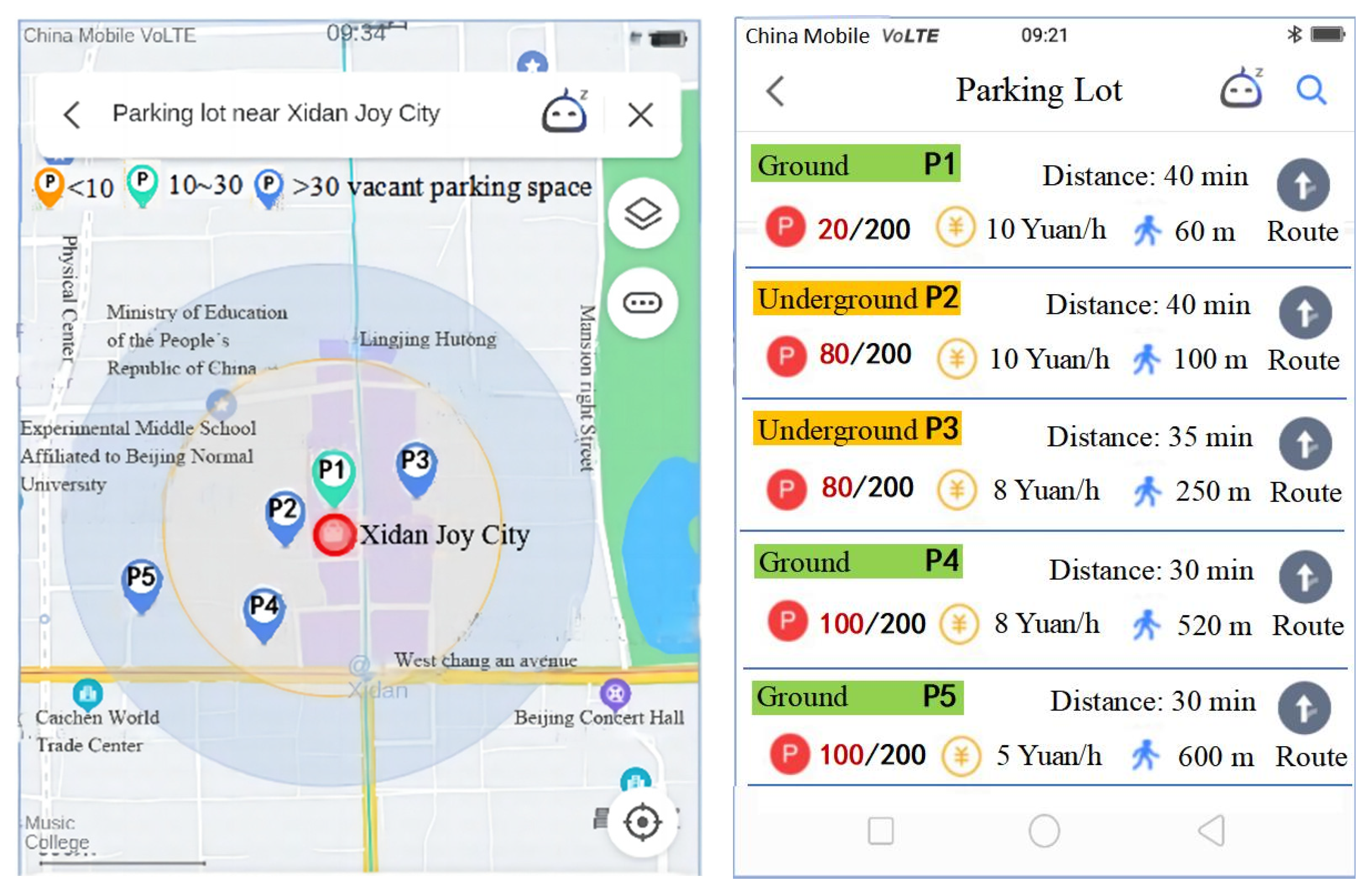
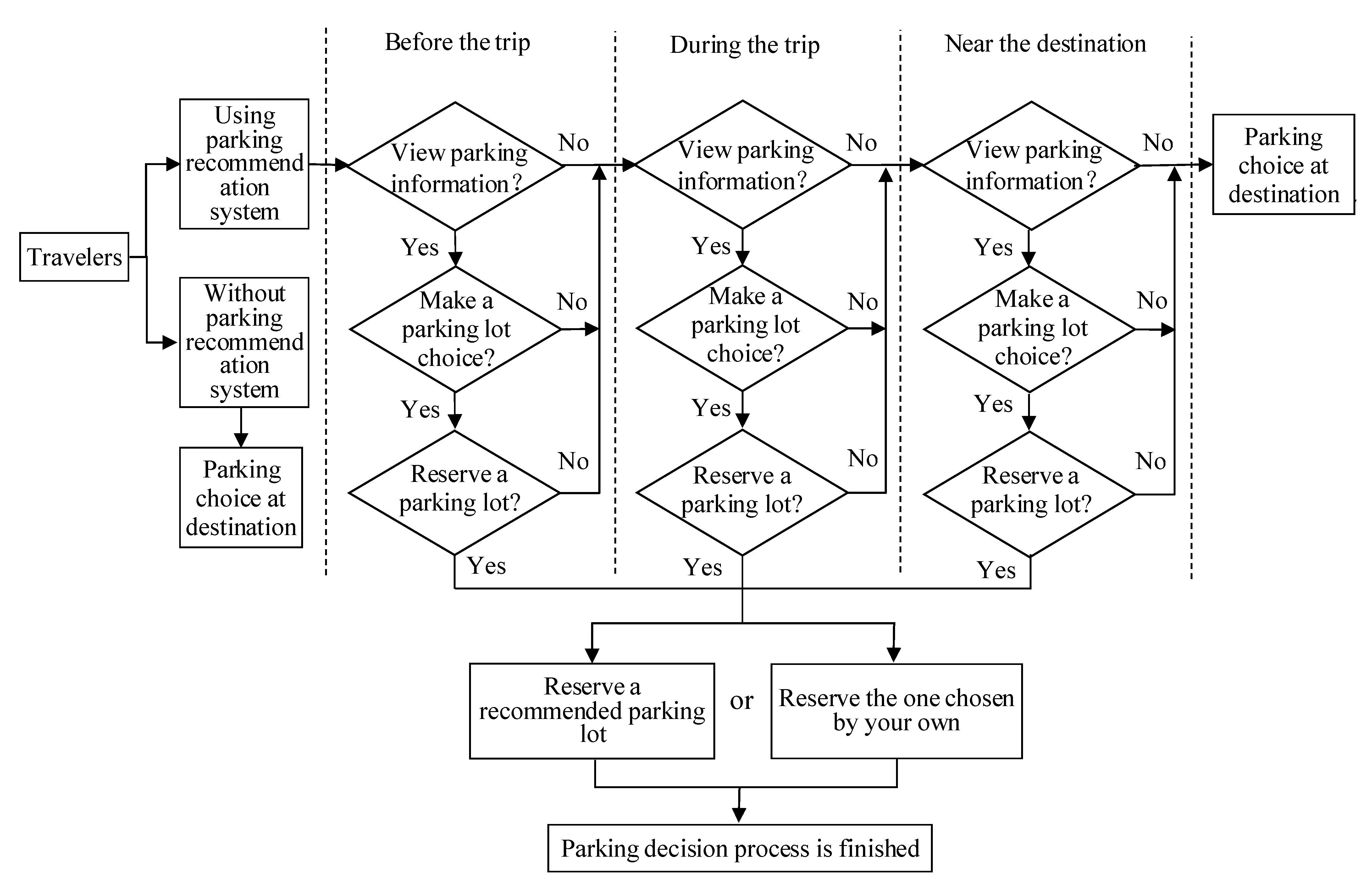
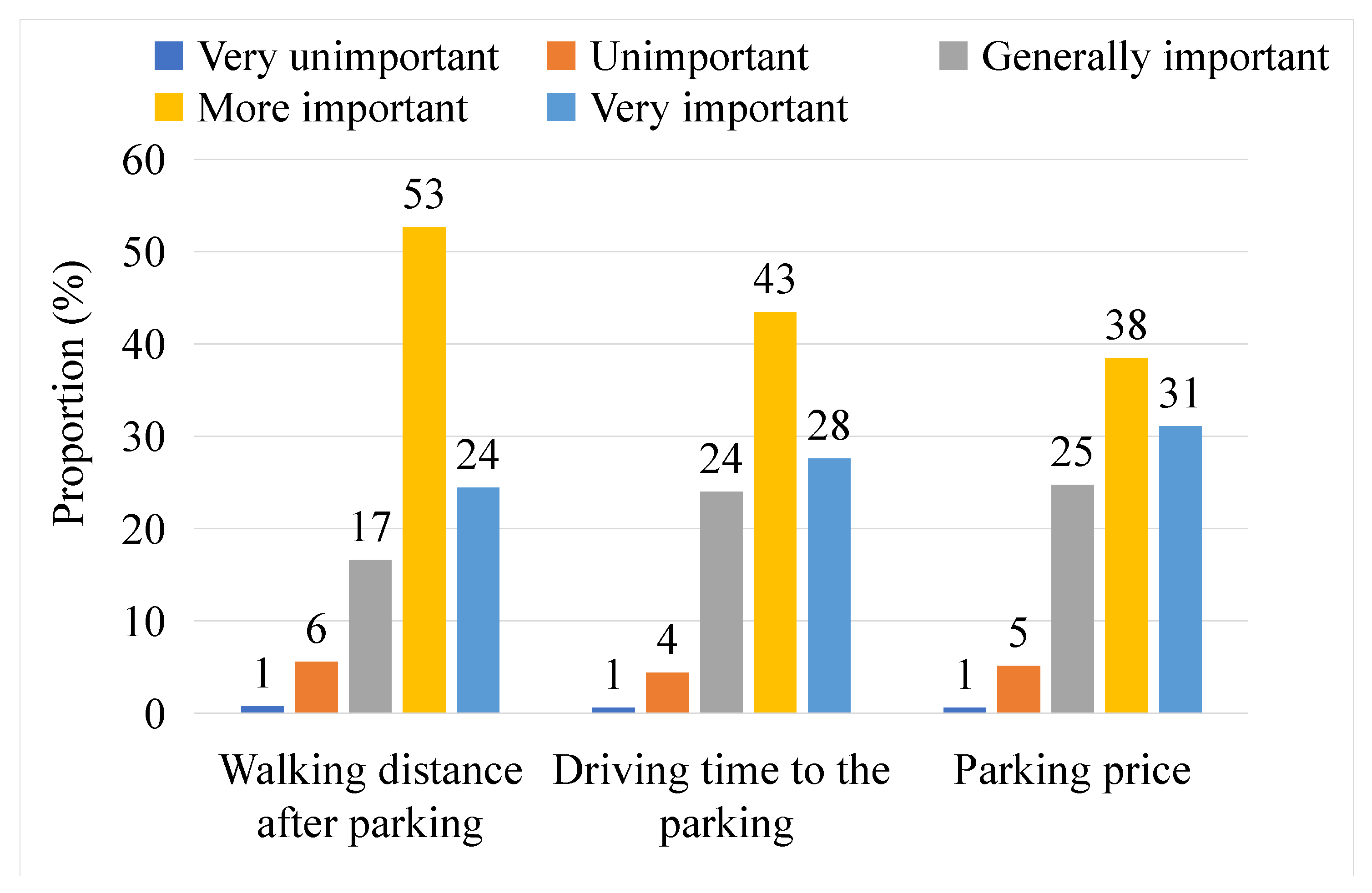
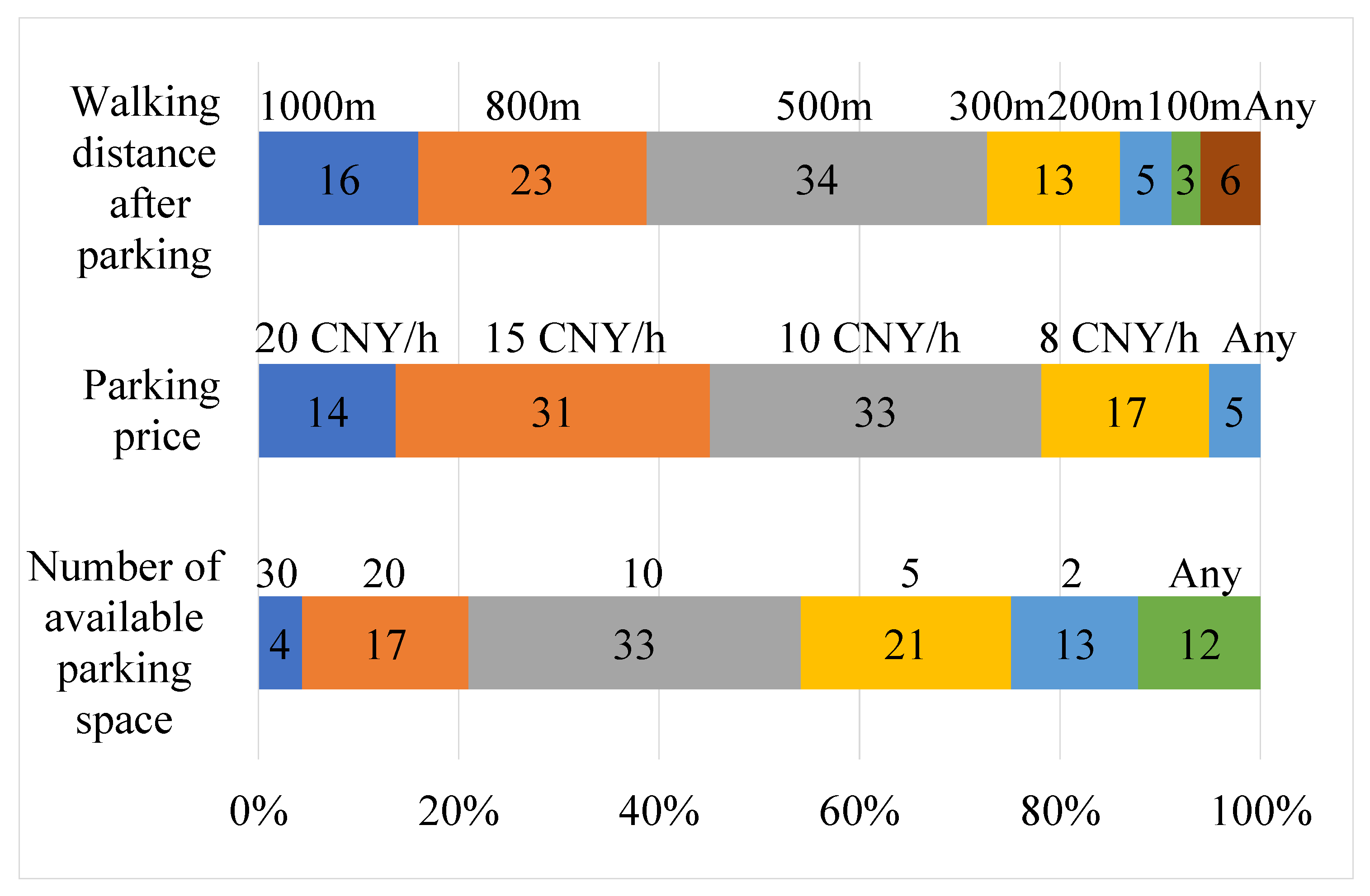

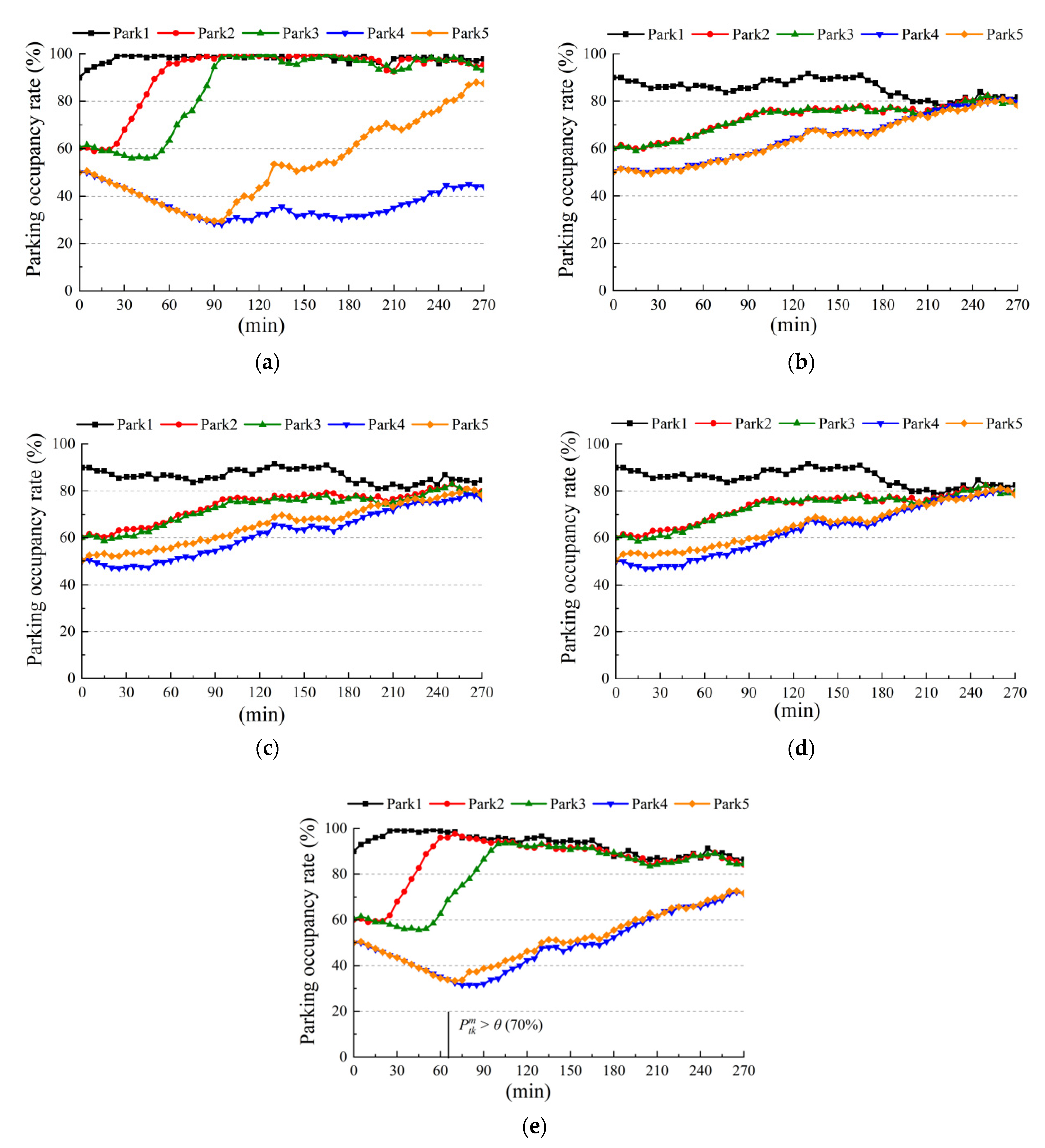
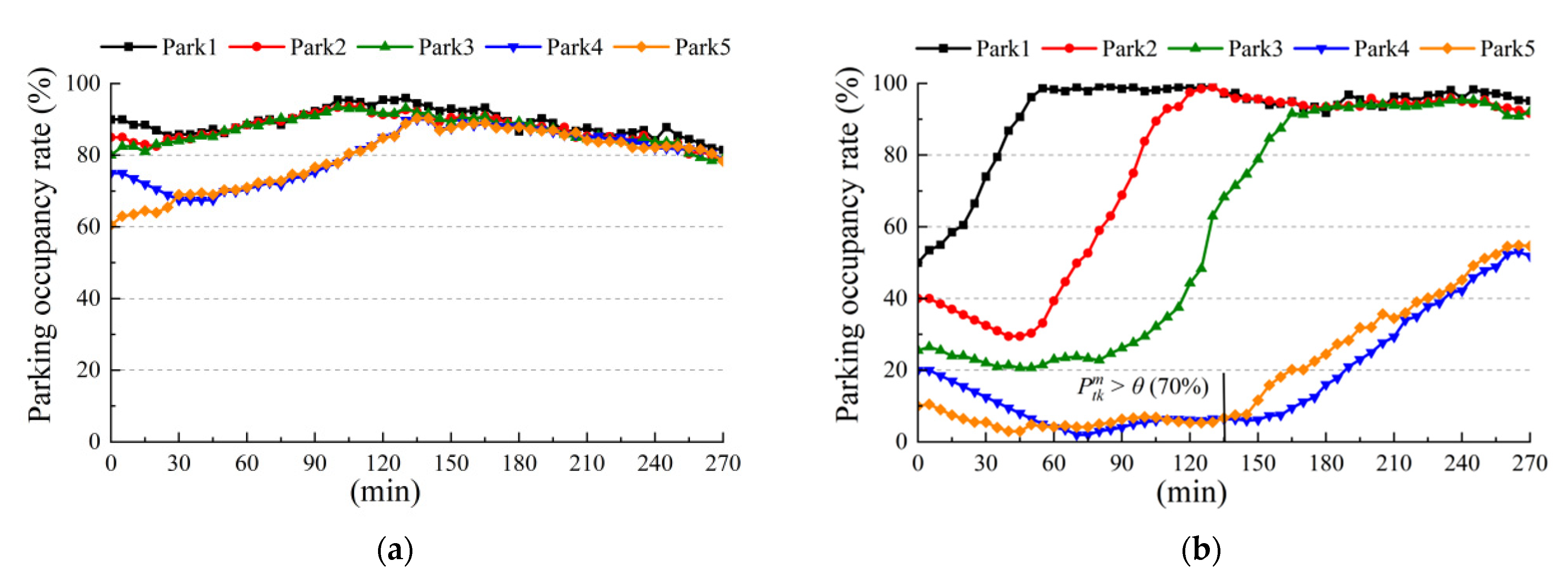
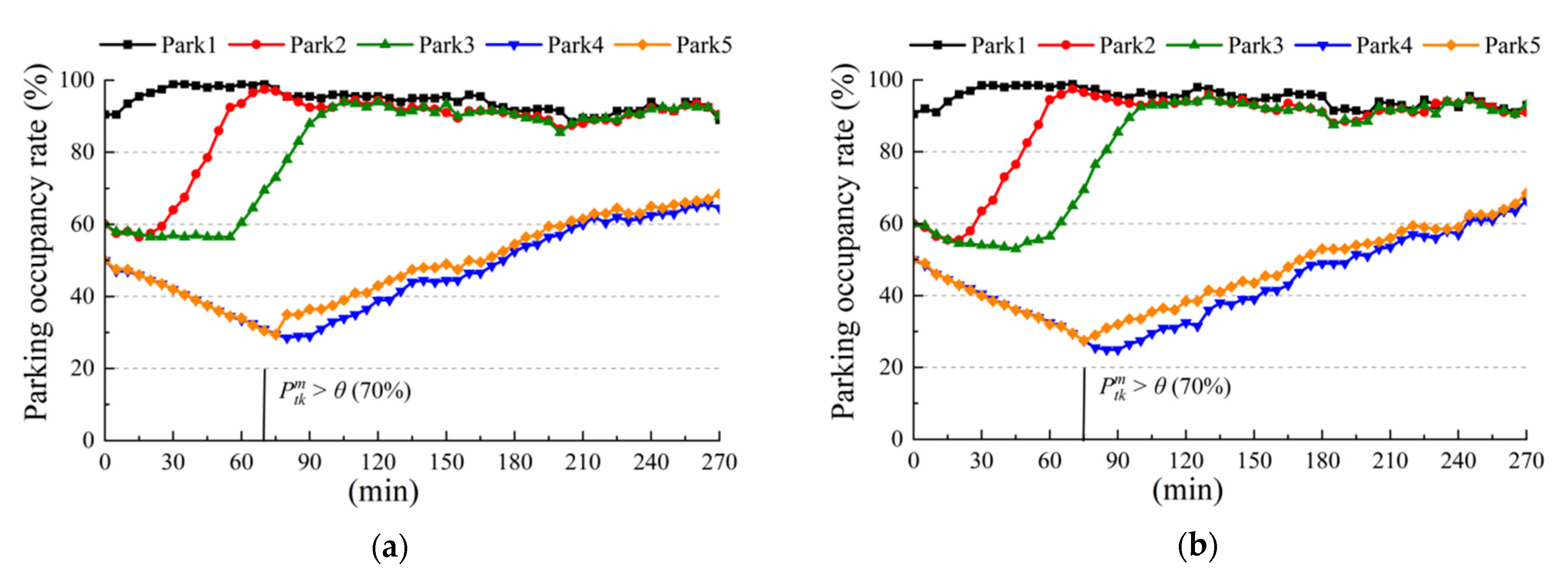

| Schemes | Adjustment Coefficient λ | Description | |
|---|---|---|---|
| Static parking recommendation | Scheme 1 | Parking recommended with the goal of maximizing the benefits of travelers. | |
| Scheme 2 | Parking recommended with the goal of balancing parking resource utilization. | ||
| Scheme 3 | Parking recommended based on the combined benefits of travelers and parking managers. | ||
| Dynamic parking recommendation | Scheme 4 | is the average occupancy rate of the parking lots near the destination at time t. If is high, then the parking lot is recommended mainly based on the benefits of parking managers. If is low, then the parking recommendation is made mainly based on maximizing the benefits of travelers. | |
| Scheme 5 | ; | is the median of the occupancy rates of the parking lots near the destination at time t. When is greater than , the parking regulation is triggered, and the parking recommendation is made based on the benefits of parking managers. When is less than or equal to , the parking lot is recommended with the goal of maximizing the benefits of the travelers. | |
| Parking Lots | Distance from the Parking Lot to the Destination, the Joy City (m) | The Number of Available Parking Spaces | Parking Price (CNY/h) |
|---|---|---|---|
| P1 | 60 | 20 | 10 |
| P2 | 100 | 80 | 10 |
| P3 | 250 | 80 | 8 |
| P4 | 520 | 100 | 8 |
| P5 | 600 | 100 | 5 |
| Schemes | Indicators Related to Travelers (All/Parking Reservation Group/Non-Parking Reservation Group) | Indicators Related to Parking Manager | ||||
|---|---|---|---|---|---|---|
| Satisfaction of Psychological Needs (%) | Average Walking Distance after Parking (m/Person) | Average Parking Fee (Including Reservation Fee) (CNY/Person) | Cumulative Parking Revenue (CNY) | |||
| All Three Factors | Primary Concerned Factor | Secondary Concerned Factor | ||||
| Scheme 1 | 71/74/66 | 84/85/83 | 82/84/80 | 267/262/273 | 24/24/24 | 28,961 |
| Scheme 2 | 97/98/96 | 92/95/89 | 91/92/89 | 298/362/211 | 24/23/23 | 28,264 |
| Scheme 3 | 97/98/96 | 92/95/89 | 91/92/89 | 294/359/209 | 24/23/24 | 28,309 |
| Scheme 4 | 97/98/96 | 92/95/89 | 91/92/89 | 297/362/208 | 24/23/25 | 28,239 |
| Scheme 5 | 92/92/91 | 91/92/87 | 89/90/88 | 287/331/227 | 24/23/24 | 28,499 |
| Scenario | Indicators Related to Travelers (All/Parking Reservation Group/Non-Parking Reservation Group) | Indicators Related to Parking Manager | ||||
|---|---|---|---|---|---|---|
| Satisfaction of Psychological Needs (%) | Average Walking Distance after Parking (m/Person) | Average Parking Fee (Including Reservation Fee) (CNY/Person) | Cumulative Parking Revenue (CNY) | |||
| All Three Factors | Primary Concerned Factors | Secondary Concerned Factors | ||||
| Initial settings | 92/92/91 | 91/92/87 | 89/90/88 | 287/331/227 | 24/23/24 | 28,499 |
| Insufficient parking spaces | 93/94/91 | 91/94/87 | 90/91/88 | 300/364/213 | 24/23/24 | 28,170 |
| Sufficient parking spaces | 87/90/84 | 89/91/87 | 88/89/86 | 261/276/239 | 24/25/24 | 29,034 |
| Scenario | Indicators Related to Travelers (All/Parking Reservation Group/Non-Parking Reservation Group) | Indicators Related to Parking Manager | ||||
|---|---|---|---|---|---|---|
| Satisfaction of Psychological Needs (%) | Average Walking Distance after Parking (m/Person) | Average Parking Fee (Including Reservation Fee) (CNY/Person) | Cumulative Parking Revenue (CNY) | |||
| All Three Factors | Primary Concerned Factors | Secondary Concerned Factors | ||||
| Initial settings | 92/92/91 | 91/92/87 | 89/90/88 | 287/331/227 | 24/23/24 | 28,499 |
| Reservation Scenario 1 | 90/92/87 | 90/93/87 | 88/90/88 | 296/342/235 | 24/23/24 | 27,880 |
| Reservation Scenario 2 | 89/92/85 | 89/93/85 | 88/90/86 | 292/340/231 | 24/23/24 | 27,513 |
| Threshold to Start Parking Regulation | Indicators Related to Travelers (All/Parking Reservation Group/Non-Parking Reservation Group) | Indicators Related to Parking Manager | ||||
|---|---|---|---|---|---|---|
| Satisfaction of Psychological Needs (%) | Average Walking Distance after Parking (m/Person) | Average Parking Fee (Including Reservation Fee) (CNY/Person) | Cumulative Parking Revenue (CNY) | |||
| All Three Factors | Primary Concerned Factors | Secondary Concerned Factors | ||||
| Initial setting of 70% | 92/92/91 | 91/92/87 | 89/90/88 | 287/331/227 | 24/23/24 | 28,499 |
| 50% | 97/98/96 | 92/95/89 | 91/92/89 | 297/362/208 | 24/22/25 | 28,239 |
| 90% | 85/88/81 | 88/91/84 | 87/89/84 | 276/307/235 | 24/24/24 | 28,679 |
Disclaimer/Publisher’s Note: The statements, opinions and data contained in all publications are solely those of the individual author(s) and contributor(s) and not of MDPI and/or the editor(s). MDPI and/or the editor(s) disclaim responsibility for any injury to people or property resulting from any ideas, methods, instructions or products referred to in the content. |
© 2023 by the authors. Licensee MDPI, Basel, Switzerland. This article is an open access article distributed under the terms and conditions of the Creative Commons Attribution (CC BY) license (https://creativecommons.org/licenses/by/4.0/).
Share and Cite
Qin, H.; Xu, N.; Zhang, Y.; Pang, Q.; Lu, Z. Research on Parking Recommendation Methods Considering Travelers’ Decision Behaviors and Psychological Characteristics. Sustainability 2023, 15, 6808. https://doi.org/10.3390/su15086808
Qin H, Xu N, Zhang Y, Pang Q, Lu Z. Research on Parking Recommendation Methods Considering Travelers’ Decision Behaviors and Psychological Characteristics. Sustainability. 2023; 15(8):6808. https://doi.org/10.3390/su15086808
Chicago/Turabian StyleQin, Huanmei, Ning Xu, Yonghuan Zhang, Qianqian Pang, and Zhaolin Lu. 2023. "Research on Parking Recommendation Methods Considering Travelers’ Decision Behaviors and Psychological Characteristics" Sustainability 15, no. 8: 6808. https://doi.org/10.3390/su15086808
APA StyleQin, H., Xu, N., Zhang, Y., Pang, Q., & Lu, Z. (2023). Research on Parking Recommendation Methods Considering Travelers’ Decision Behaviors and Psychological Characteristics. Sustainability, 15(8), 6808. https://doi.org/10.3390/su15086808








